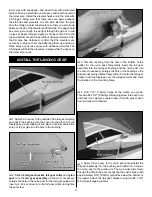
22
Not only will motor mounting screws loosen, possibly with
disastrous effect, but vibration may also damage your radio
receiver and battery.
We use a Top Flite Precision Magnetic Prop Balancer
(TOPQ5700) in the workshop and keep a Great Planes
Fingertip Prop Balancer (GPMQ5000) in our fl ight box.
Range Check
Ground check the operational range of your radio before the
fi rst fl ight of the day. With the transmitter antenna collapsed
and the receiver and transmitter on, you should be able to
walk at least 100 feet away from the model and still have
control (follow the instructions that came with your radio if
you are using a 2.4GHz system). Have an assistant stand
by your model and, while you work the controls, tell you
what the control surfaces are doing. Repeat this test with
the motor running at various speeds with an assistant
holding the model, using hand signals to show you what is
happening. If the control surfaces do not respond correctly,
do not fl y! Find and correct the problem fi rst. Look for
loose servo connections or broken wires, corroded wires
on old servo connectors, poor solder joints in your battery
pack or a defective cell, or a damaged receiver crystal from
a previous crash.
MOTOR SAFETY PRECAUTIONS
Failure to follow these safety precautions may result in
severe injury to yourself and others.
Get help from an experienced pilot when learning to
operate motors.
Use safety glasses when running motors.
Do not run the motor in an area of loose gravel or sand; the
propeller may throw such material in your face or eyes.
Keep your face and body as well as all spectators away from
the plane of rotation of the propeller as you run the motor.
Keep these items away from the prop: loose clothing, shirt
sleeves, ties, scarves, long hair or loose objects such as
pencils or screwdrivers that may fall out of shirt or jacket
pockets into the prop.
The motor gets hot! Do not touch it during or right
after operation.
LITHIUM BATTERY
HANDLING & USAGE
WARNING!! Read the entire instruction sheet included with
your battery. Failure to follow all instructions could cause
permanent damage to the battery and its surroundings,
and cause bodily harm!
•
ONLY use a Li-Po approved charger. NEVER use
a NiCd/NiMH peak charger!
•
NEVER charge in excess of 4.20V per cell.
•
ONLY charge through the “charge” lead. NEVER
charge through the “discharge” lead.
•
NEVER charge at currents greater than 1C.
•
ALWAYS set charger’s output volts to match
battery volts.
•
ALWAYS charge in a fi reproof location.
•
NEVER trickle charge.
•
NEVER allow the battery temperature to exceed
150° F (65° C).
•
NEVER disassemble or modify pack wiring in any
way or puncture cells.
•
NEVER discharge below 3.0V per cell.
•
NEVER place on combustible materials or leave
unattended during charge or discharge.
•
ALWAYS KEEP OUT OF REACH OF CHILDREN.
AMA SAFETY CODE
(EXCERPTS)
Read and abide by the following excerpts from the Academy
of Model Aeronautics Safety Code. For the complete Safety
Code refer to Model Aviation magazine, the AMA web site or
the Code that came with your AMA license.
General
1) I will not fl y my model aircraft in sanctioned events,
air shows, or model fl ying demonstrations until it has
been proven to be airworthy by having been previously,
successfully fl ight tested.
2) I will not fl y my model aircraft higher than approximately
400 feet within 3 miles of an airport without notifying the
airport operator. I will give right-of-way and avoid fl ying
in the proximity of full-scale aircraft. Where necessary,
an observer shall be utilized to supervise fl ying to avoid
having models fl y in the proximity of full-scale aircraft.
3) Where established, I will abide by the safety rules
for the flying site I use, and I will not willfully and
deliberately fly my models in a careless, reckless and/
or dangerous manner.
5) I will not fl y my model unless it is identifi ed with my name
and address or AMA number, on or in the model. Note:
This does not apply to models while being fl own indoors.
7) I will not operate models with pyrotechnics (any device
that explodes, burns, or propels a projectile of any kind).
Radio Control
1) I will have completed a successful radio equipment ground
check before the fi rst fl ight of a new or repaired model.



































